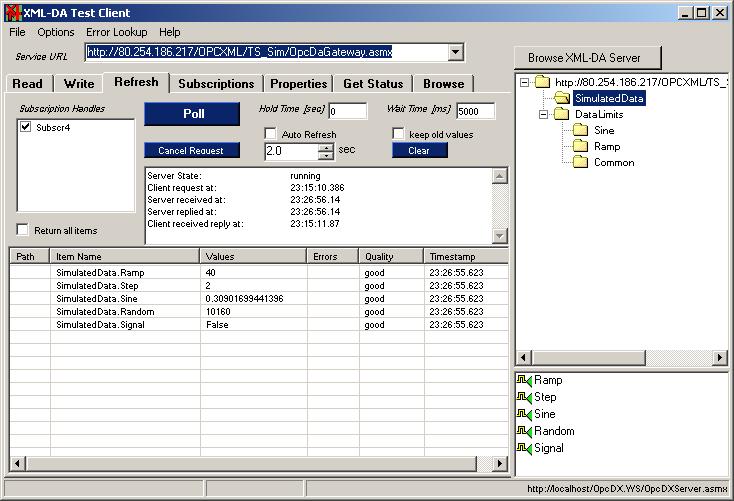XML DA / OPC DA .Net Client Development Component
Version Info
 |
XMLDA.NET is a .NET component that handles all OPC Data Access needs.
|
|
.NET2 Windows Forms Applications
|
.NET2 ASP.NET Applications
|
.NET3 WCF/WPF Applications
|
|
OPC-DA V2/V3 Servers
|
yes
|
yes
|
yes
|
|
XML-DA Servers
|
yes
|
yes
|
yes
|
|
XMLDA.NET provides .Net proxy assemblies for the server access that can be used in all kinds of .Net applications (Windows Forms, Console applications, Windows services, ASP.NET, WPF desktop or browser applications ) to access local or remote OPC-DA or XML-DA servers. XMLDA.NET contains a high performance OPC-DA wrapper for access to local OPC-DA servers. XML-DA server can be accessed either with minimal security as .NET2 web services or with any of the bindings supported by the .NET3 Windows Communication Foundation (WCF).
The client applications can be implemented as XML-DA clients and have the proper design for web services. XML-DA defines only eight methods and is much easier to use than the OPC-DA interface with it's about seventy functions. |
 |
XMLDA.NET Feature Overview
| Standards based |
XMLDA.NET supports access to OPC-DA and XML-DA servers and has an XML-DA client interface. The use of only standardized interfaces minimizes training requirements and ensures high flexibility.
|
| Web Services |
XML-DA is designed for web service applications and offers all the features necessary for ASP.NET applications and for access to remote servers.
The server communication can either be based on .NET2 web services or .NET WCF.
|
| Windows Applications |
The XML-DA interface is also well suited for Windows Forms of WPF desktop applications. The low number functions and the state-less design make use simple and straightforward. A Read or Subscribe can be called without first having to create groups etc.
|
| OPC DA Support |
Access to OPC-DA servers is handled by the XMLDA.NET internal high performance wrapper. Wrapping from XML-DA to OPC-DA is much less problematic than the other direction. The type of the server is not visible to the client. All client applications work with both types of servers.
|
| Data Binding |
The XMLDA.NET DataBinding subscriptions handle callbacks/server polls and update user classes and Windows Forms/WPF controls without need for user callback handlers. In ASP.NET applications they work together with the ASP.NET DataBind feature.
|
| Browse Support |
BrowseTree classes handle the server browsing and the display/selection in Windows Forms/WPF TreeView controls.
|
| ListBuilder |
The ListBuilder tool/class support the interactive definition of the request list need in XML-DA method calls. Coding is reduced to a minimum. Complex applications can be realized with a few lines of code if the ListBuilder and DataBind features are combined. |
DataBind Subscriptions
XMLDA.NET V2 offers additional methods to minimize and further simplify the application code. The DataBind subscriptions eliminate the need for the user to handle server callbacks or to poll XML-DA servers. Server items are assigned to different types of application objects:
- Windows Forms or WPF controls
|
Server items can be assigned to all kinds of Windows controls such as CheckBoxes, TextBoxes, ListViews. The disply is refreshed whenever the server reports a value change. No user code is required. |
|
|
The XMLDA.NET DataBind subscriptions work with the ASP.NET DataBind feature to update displayed item values whenever the browser makes a postback. |
|
|
Server items can be assigned to properties of any user defined class. The property SET accessor is executed as the server callback handler. |
DataBind subscriptions have optional properties that control how the item value is formatted and how the item quality and errors are handled.
.NET3 (WCF)
XMLDA.NET is provided in version for .NET1.1, .NET2 and .NET3.
The .NET3 (WCF) communication can be configured for differnet communication protpcols such as:
- basic HTTP for compatibility with .NET2 web services
- secure HTTP with authetication and message encryption
- TCP for high performance
Secure communication is implemented on the industry standards WS-Security 1.0 and 1.1, WS-Trust, WS-SecureConversation, WS-Addressing and Message Transmission Optimization Mechanism (MTOM).
The benchmark measurements show that XML DA server access with TCP protocol has a performance similar to DCOM based access to a remote OPC DA server.
Item List Builder Tool / Class
The ListBuilder tool creates XML files with item definitions as they are required in OPC XML DA server calls. The screen image shows the definition used in the above sample application. The sample application uses the ListBuilder Class to load the XML file and extract the request list for the read call.

Test Client
The TestClient application can access OPC DA and XML DA servers. The type of server accessed depends on the server URL. If it starts with http:// then it's assumed to be the URL of an XML DA server. Otherwise it's assumed to be the ProgID of an OPC DA server.

XMLDA.NET Sample Applications
See How To Develop OPC Clients Today for a comparison of the different approaches for developing .Net OPC Clients and read the XMLDA.NET White Paper for a technical overview..
XMLDA.NET Feature Summary
| System Requirements |
 |
Windows 7, 8.x, 10 or Windows Server 2008, 2012, 2016 |
 |
32-bit or 64-bit |
 |
NET Framework 4.x |
 |
Visual Studio 2010,2012,2013,2015 or 2017, C# or Visual Basic |
Download the free Evaluation Version by clicking 'Add To Cart' below. This is a full featured version including the sample client source code. The run time is however limited to 30 minutes, requiring the application to be restarted.
|
